Mike Vardy's Blog, page 56
October 16, 2017
Why Reflection is Critical to Your Personal Productivity
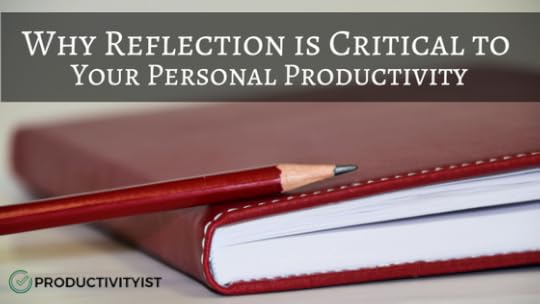
I have a question for you: When was the last time you looked back at what already happened today instead of looking forward to tomorrow?
Most of us tend to look ahead because that’s the direction we’re moving. But the problem is that if you only look ahead, and don’t take the time to reflect on what led you to this point, then you could wind up going down the wrong path. When that happens, you have to spend time figuring out how you got there, and then try to forge a new path to get to where you want to go, and more.
All of these things that you are forced to do when you head in the wrong direction can be largely avoided if you take time to reflect.
While taking time to reflect doesn’t seem simple, it really is. You just need to make time for it. Find a time every day to do it. Ideally, you should be doing it later in the day (as late as you can before you are too tired to do it well).
Think of each day as a mini-lifetime. Early in the day you’re still brand new to the world. By the end of the day, you’re older and wiser. You can better assess what went well (and what didn’t) so that you can best inform your ancestors – your future selves – what they can do to stay on course.
The best way to do this type of daily reflection is by journaling.
If you like to write by hand, get a meaningful notebook to write in. If you’re more of a digital person (or are too tired to handwrite later in the day), then use an app like Day One, Journey, or even Evernote to chronicle your thoughts and feelings on the day.
If you need help fostering this journaling habit, Take The Productivityist Small Wins Journaling Challenge. It’s worked for plenty of Productivityist readers…and it’s free. If you put the time and effort in, it’ll work for you too. Click here to take the challenge.
Reflection is critical to your personal productivity. If you don’t take (and make) time to figure how you got to where you are, then you are going to waste valuable time trying to get to what you need and want to be doing.
The post Why Reflection is Critical to Your Personal Productivity appeared first on Productivityist.
October 15, 2017
Protected: Integrity
This content is password protected. To view it please enter your password below:
Password:
The post Protected: Integrity appeared first on Productivityist.
October 11, 2017
The Art of Taking Action with Gregg Krech
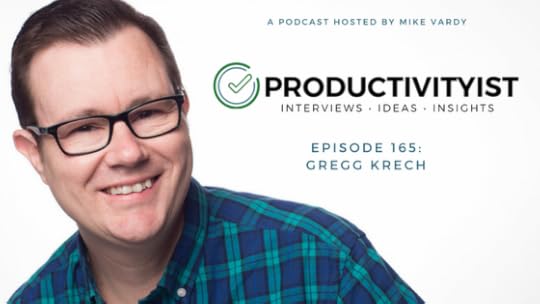
On this episode of the podcast, I welcome Gregg Krech to the program. Gregg is one of the leading experts on Japanese Psychology in the U.S. He is the author of 5 books including The Art of Taking Action: Lessons from Japanese Psychology, which has become an Amazon best seller and offer practical strategies for integrating ideas from Eastern philosophy with contemporary Western living.
Gregg and I spend time discussing how he got into Japanese psychology, why Eastern ways are appealing to Western cultures, perfectionism and being obsessed with the unfinished, and even look deeper into Kaizen. I had an incredible time chatting with Gregg and I trust you’ll find this to be a rather compelling conversation.
Relevant Links
The ToDo Institute
Facing the Demons of Inaction: Morita Therapy as a Resource for Moving Forward
Jon Acuff episode of The Productivityist Podcast
Art of Taking Action
ToDo Institute Courses
ToDo Institute | Facebook
Thanks for listening. If you enjoyed the show don’t forget to subscribe so you don’t miss a single episode. Until next time remember to stop guessing…and start going!
If you’re interested in supporting the podcast and receiving exclusive content while doing so, you’ll want to check out the patrons-only version of The Productivityist Podcast on Patreon. Also, remember to leave The Productivityist Podcast a rating and review on iTunes, or on whatever platform you’re listening to. I read every single bit of feedback we receive. I want to make this show better and with your help I can do that.
The post The Art of Taking Action with Gregg Krech appeared first on Productivityist.
October 9, 2017
This is What You Do

You get up at whatever time you need to get up. Maybe it’s early because you go to bed early and want those morning hours for yourself or maybe it’s later because you’re more of a night owl and thrive in the evening hours.
You grab some form of breakfast. Sometimes it’s whatever you can throw together. Sometimes it’s something you prepared in advance. Sometimes it’s drive-thru.
You get anyone other than you ready for the day ahead. Maybe it’s your partner at home. Maybe it’s your partner (or partners) at work. It could be your children. It could be your colleagues. It could be anyone but you.
You start your commute. You listen to whatever is available – the car stereo, your mobile device, the din of your surroundings. Sometimes you have a plan for this so you can enjoy the journey. Sometimes you just want to get to your destination and could care less about what happens along the way.
You get to work. You do the things at work that you have to do. There are days when that goes smoothly. There are days when more things show up than usual. That’s when you long for those days that go smoothly.
You take breaks. Sometimes. You might even leave your desk for some of them.
Your workday officially comes to a close. Sometimes you end it at that time and head home. Sometimes you work beyond those hours so you can get that “one last thing” done before heading home. Sometimes you do it once you are home.
And sometimes work time and home time bleed into one another.
You eat dinner. If it’s planned in advance, you know what to expect. If not, you could be eating take-out. Or you could just be eating late.
You help the household settle in for the night. You might read your youngest a story, being mindful that you won’t always get to do this. Sometimes you might read a story but your mind is full of something else entirely.
You spend time with your partner. Sometimes it’s in animated conversation. Sometimes it’s reading a book…separately but together. Sometimes it’s reading your mobile phones…separately. Sometimes that partner is (once again) the one you have at the office.
You go to bed when you need to go to bed. Maybe it’s early because you’re an early riser and you’re at your best in the morning hours. Maybe it’s late because your primetime is in the evening.
Then what you do starts all over again.
If any part of the above describes what you do, then I’d like you to ask yourself the following:
Is that really what you need or want to be doing?
Think about why any (or all) of that is your “what” and write that down. Be brutally honest with yourself on this. As Simon Sinek said, “People don’t buy what you do; they buy why you do it. And what you do simply proves what you believe.” (Remember that you are people too.)
Wonder how you can align “why you do what you do” with “what you are doing” so that course correcting is less challenging. Then put ONE of those into action. (Want my help with this? Then sign up for my Do YOUR Things free email course by clicking here.)
If you want to be more personally productive, then this is what you do. Doing anything less removes the “personally” from the equation. And that’s when you find yourself doing productive instead of being productive.
The post This is What You Do appeared first on Productivityist.
October 5, 2017
The Daily CT Scan: The Best Way To Start Your Day

A scan is defined by Merriam-Webster as “…to examine by point-by-point observation or checking.” However, the definition goes deeper into that:
to investigate thoroughly by checking point by point and often repeatedly
to glance from point to point often hastily, casually, or in search of a particular item
Scanning, whether using either of those definitions, can give you the information you need to make a decision. And being able to make informed decisions is something that can really make a difference in your personal productivity.
You need to start your day by making several decisions so you know what action(s) to take. That’s why it’s important to scan two things right when you start your day: your calendar and your to-do list.
Now, this may seem obvious because both of those tools house vital information for your day, but when was the last time you scanned those two things first before doing anything else?
Before the news? Before email? Before Facebook?
If you can honestly say that you check your calendar and to-do list first thing in the morning, then I’m going to save you some time: stop reading this piece. You know what you need to do. Do it.
But if you’re trying to figure out why The Daily CT Scan is the best way to start your day, read on. First, let’s parse The Daily CT Scan into its parts:
C is for Calendar
The first thing you should look at daily is your calendar. It offers you a look at the hard edges of your day, which include things like:
Appointments
Daily Themes
Monthly Themes
Horizontal Themes
Weekly Sprints
The first item (appointments) is pretty well understood. If you have made a commitment to meet others, then it is an appointment. Meetings fall into this category, as do any things you need to do at a specific time of day.
If you want, you can schedule regular appointments with yourself. I usually schedule these as Horizontal Themes. Common Horizontal Themes include exercise, morning and evening routines, email review, and social media updating. If you want to learn more about Horizontal Theming, check out The Productivityist Playbook.
The other items fall into the idea of “time theming” which is one of the core components of the personal productivity methodology I teach called TimeCrafting. Essentially “time theming” is using your calendar to create a framework through the use of overarching areas of focus for each day, week, and month of the year.
I can work with you personally through the process of theming your time in the upcoming Beyond Productivity Group Coaching Intensive. It’s a four-week program that is designed to help you build better boundaries, design and define your days, funnel your focus, and review and refine your daily workflow. You can learn more about the program and claim one of the few spots available here.
Even if you don’t theme your time, by checking your calendar first you will have an awareness of what commitments you’ve made to others throughout your day. That awareness will allow you to navigate the day far more intentionally.
Now it’s time to review the details of your day. You’ll find those in your to-do list.
T is for To-Do List
As I mentioned, this is where the fine print of your day exists. Basically, everything on your to-do list should be related to a deadline or due date of some sort. Some of those are imposed by others, and some are self-imposed.
How you deal with both in harmony is key.
This is why checking your calendar first is so important. If your day is filled with appointments, then getting any deep or focused work done is going to be challenging. If you have a day of the week that is more open, then you can dive into those tasks that will require longer stretches of uninterrupted time.
Ideally you should categorize your tasks on your to-do list by using whatever mode you need to be in to complete them. Sure, you can also work on your tasks by project as you see fit, but by assigning one mode (or more) to each task, you now have another way to look at your work every day. The other benefit of doing this: your Daily CT Scan is easier to do because you’ve segmented your to-do list just that much better.
There are 5 categories of modes that I refer to when crafting my time and shaping my to-do list. I’ve created a simple PDF that you can download for FREE so that you can get started with “mode-based work” now. Just click here and I’ll send it your way.
The Daily CT Scan also has a compounding effect. When you do it every day (especially at the start of the day), you’ll forge a stronger sense of awareness. You’ll feel more confident as you take on the day because you’ll know what commitments you’ve made to others and to yourself. You’ll be able to craft the day to work better for you. It only takes a few minutes to do every morning, and it will save you far more time over the long haul.
Ultimately, The Daily CT Scan is the best way to start your day because it puts you in the position to run your day instead of it running you.
The post The Daily CT Scan: The Best Way To Start Your Day appeared first on Productivityist.
October 4, 2017
Faster Than Normal with Peter Shankman
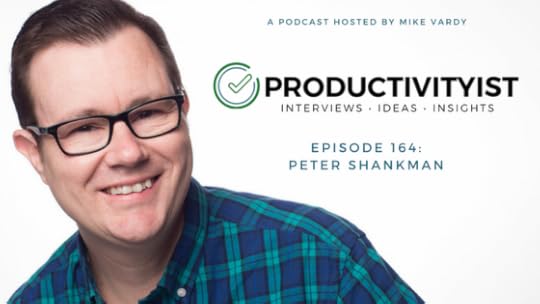
Peter Shankman joins me on this episode of the podcast. Peter is the founder of Help A Reporter Out and the author of the new book Faster Than Normal.
During our conversation, we dive into why he considers ADHD to be a gift, how he leverages dopamine to boost his productivity, and what people without ADHD can do to tap into some of the productivity benefits they have at their disposal.
Relevant Links
Faster Than Normal
Bill Burr | The Tim Ferriss Show
Rich Roll
OmmWriter
The Mode That Helps Your Productivity Take Flight | Productivityist
Peter Shankman | Website
Thanks for listening. If you enjoyed the show don’t forget to subscribe so you don’t miss a single episode. Until next time remember to stop guessing…and start going!
If you’re interested in supporting the podcast and receiving exclusive content while doing so, you’ll want to check out the patrons-only version of The Productivityist Podcast on Patreon. Also, remember to leave The Productivityist Podcast a rating and review on iTunes, or on whatever platform you’re listening to. I read every single bit of feedback we receive. I want to make this show better and with your help I can do that.
The post Faster Than Normal with Peter Shankman appeared first on Productivityist.
October 2, 2017
How to Get Some Breathing Room

The following is a guest post by my good friend Shawn Blanc, creator of The Focus Course . Shawn is a writer, small-business owner, productivity coach, and creative entrepreneur. For more than a decade, Shawn has been teaching and learning about creativity, diligence, and focus.
In a word or two, how would you describe your average day?
Busy?
Overwhelming?
Relaxing?
Pointless?
Productive?
Boring?
Stressful?
Fulfilling?
For me, in this season of life, I’d say that my average day is a mixed bag. While most days are productive on paper, they feel a little bit too busy and a little bit too stressed.
As a small-business owner, sometimes my responsibilities have me pulled in a half-dozen directions. Between all my spinning plates, well, life can feel frazzled at times.
But I’m not alone here, am I? You’re busy, too. We all are.
From the rising of the sun until long after it sets, how quickly our days get filled with things to do. Important responsibilities. Urgent issues. Helping and serving the people who depend on us.
My ideal day would be fulfilling, with times that are both relaxing and productive.
I’m about as “Type A” as they come. I’ve always got more ideas than time and I feel most energized when I’m working on a project. The downside is that means it can be hard for me to stop working and even to stop thinking about work.
In his book, Margin, Richard Swenson, M.D., starts out with this statement:
The conditions of modern-day living devour margin. If you are homeless, we send you to a shelter. If you are penniless, we offer you food stamps. If you are breathless, we connect you to oxygen. But if you are marginless, we give you yet one more thing to do.
Not only are we given one more thing to do, many of us are even seeking out more to do — perhaps intentionally, but most likely unintentionally — simply because we struggle to say ‘no’ to requests of our time and attention and thus are busy beyond capacity. When we do have a spare moment, we fill it quickly without thinking by checking the news, social media, and email, almost as if by habit.
“No matter how busy life gets,” writes Jessica Turner in her book The Fringe Hours, “I’m here to tell you that you not only can but must make time to do things that matter to you.”
When you think of margin in your life, think of health. Physical health, emotional health, mental health, relational health, financial health, creative health.
Margin in your finances means you’re living within your means and even have a rainy day fund.
Margin in your schedule means you have time to do the things you need to do as well as the things you want to do.
Margin in your emotions means you don’t live constantly on the edge — losing your temper or your patience at the drop of a hat.
Margin for your thoughts means you have the wherewithal to make clear decisions and focus on your most important work.
All of these areas overlap with one another — they’re not isolated. Which is why, when a household lacks margin in its finances it can erode at margin in the marriage. Or when we lack margin in our schedule, it can erode the margin in our emotions.
Here are three signs you may need some margin in your day:
You feel fatigued, hurried, and anxious rather than excited, calm, and secure.
You have little or no time for your own projects and passions because your day is filled up having to respond to so many other urgent issues.
You often wake up to your day, rather than waking up for your day.
Why is margin important?
We need margin. You need it. And so do I.
Without margin in our finances, we fall deeper in debt every time the car breaks down. Without margin in our schedule, we have no time to rest, recharge, or serve others. And without margin for our thoughts, we lack creative energy to make progress on our most important work.
Though, not always, oftentimes our lack of margin is self-inflicted.
We would love to have a rainy day fund, but when we see a bigger television for a cheaper price, we buy the TV instead of setting that money aside. We would love to have time at the end of the day to read a good book, but when we come home from work we instinctively turn on said television. We would love to make progress on our side-project, but when we have a break, we spend it check our social media timelines.
Listening to Overwhelm
Again, Swenson writes:
No one likes pain. We all want to get rid of it as soon as possible. But physical pains are usually there for a reason, to tell us something is wrong and needs to be fixed. Emotional, relational, and societal pains, too, are often indicators that all is not well. As such, they serve a valuable purpose — they help us focus.
Modern-day living, however, opposes focusing. Surrounded by frenzy and interruptions, we have no time for anything…
Do You Need a Change or Are You On the Verge of a Breakthrough?
Though they are related, Margin and Stress are not the same thing. A lack of margin can (and usually will) cause stress. Being overloaded and overwhelmed is usually what can lead to the pain of stress.
When you’re feeling the pain of overwhelm, listen to it.
There can be two reasons for the stress you feel:
It may be that life is telling you you’re marginless.
Or, sometimes that feeling of overwhelm is because you’re in a season of transition — you’re close to a breakthrough.
When it’s the former, you need to dial down, say no to some things, and create some margin in your day. Get yourself some breathing room.
However, when it’s the latter — when you’re on your way toward a breakthrough in your skills — you need help and the perseverance to press through.
Let’s talk about these two things. Let’s look at ways to dial down when you’re overloaded, as well as how to persevere when you’re on the cusp of a breakthrough.
Simple Ways You Can Quickly Restore Margin In Your Life
Again, in his book, Margin, Richard Swenson writes that “to be healthy, we require margin in at least four areas: emotional energy, physical energy, time, and finances.”
If you’re feeling overloaded, I bet you could get one or two “quick wins” for your emotional energy, physical energy, time, or finances — little ways to give yourself some breathing room.
Start by taking inventory of where you’re spending the bulk of your time, money, and energy. (Not where you wish you were spending it, but where you’re actually spending it.)
What can be subtracted? What can you do to give your schedule, your emotions, your mind, your body, and/or your finances some breathing room?
Here are some suggestions for quick wins for you. These can help stop the bleeding. And, with a small victory, you can begin to get some momentum going in the direction you need.
Physical Energy
There are some very simple ways to help get your body active if you’re feeling underachieved and not physically strong. Get enough sleep at night (which probably means going to bed on time). Take a 30-minute walk most days. Eat less sugar.
Not to sound like your mother, but healthy disciplines are easy to abandon when life gets crazy. I know that for me, my daily workout is usually the first thing to go when I’m feeling overloaded. So I certainly need the reminder about just how important physical health is to doing my best creative work.
Emotional Energy
You need social support (community). And, to be candid, you probably could do with less Screen Time.
For the former, ask a friend or family member for support. Even if it’s just to let them know you’re feeling overloaded and you need to talk about it. Also, take a moment to give to someone by encouraging, helping, or supporting them.
For the latter, next time you feel the urge to check your Social Network of Choice when you have a down moment, consider opening up your journal or notes app instead and writing down something you’re thankful for.
(See also this Tim Ferris podcast episode, The Magic of Mindfulness, and the EntreLeadership podcast episode with Shawn Achor.)
Time
You’re smart enough to know that you’ll never “find” time. You have to make it. If your schedule is full, the only option is to begin saying no to things. I’d start with television if you haven’t already. Then I’d start with taking an hour or two at the beginning of your week to plan how you’ll be spending your time over the next 7 days.
Mike’s Clarity Day is an excellent way to get some margin back into your schedule.
Finances
If you need to restore margin to your finances, start by cutting something out of your budget. Perhaps begin making coffee at home; or stop ordering fancy drinks and dessert at restaurants; sell your car to get rid of the payments and buy something less fancy for cash. These types of changes aren’t easy to make, but they’re a way of taking charge of your finances and learning to live within your means.
I’d also highly recommend you set up a rainy day fund if you don’t have one already. Save $1,000 as fast as you can. (Figure out how to get an extra $34/day and you’ll have that $1,000 in less than a month.)
Staying Sane In the Midst of a Busy or Challenging Season
If, however, you are not lacking margin in general, but rather are in the midst of particularly busy or challenging season of life, what you need is the ability to press through.
If you’re on the edge of a breakthrough, keep going.
What do I mean by “on the edge of a breakthrough?”
When you’re learning something new or transitioning to a different season of life, you have to “break through” from where you were to get to where you’re going.
Perhaps it’s that you’re starting a new business. Or you’re learning a new skill. Or you want to get better at budgeting. Or you’re writing a book. When you’re first starting out and you’re at the very outside of that new thing, it doesn’t seem quite so scary. But then, once you begin making a little bit of progress, you realize just how much you don’t know, and that state can be overwhelming.
It feels overwhelming because you suddenly begin to see so many open ideas, moving parts, and hazy concepts. You can see everything moving around, but it’s all in a fog and doesn’t make sense yet. You have a ton of unanswered questions, and you don’t even know who to go to for help or what you would even ask them.
Basically, you’re in the midst of a heightened season of “deep work,” and it’s not easy.
Instead of quitting, keep on learning. Keep pushing through. Eventually, the fog will lift, the dots will connect, and you’ll get that breakthrough.
It is in these seasons of overwhelm — when life is at its busiest — that it becomes all the more important to be intentional with how you spend your time. **
Here are the ways I stay focused during especially busy or challenging seasons of life (such as the one I’m in right now, as a matter of fact):
Making sure my day is filled with intentional work. Step one is knowing what to do and having a plan of when I’m going to do it. This is so important that I’ve actually been spending more time managing my time. The days can so quickly get away from me that I’m upping my intentionality to make sure my daily and weekly schedule is providing me with the time I need to do the most important work.If I’m mostly in a reactive state — giving my attention primarily to the incoming inboxes of email and Twitter — then chances are I’m wasting time. This is why I’ve been spending even less time than usual on email and Twitter…
Dialing back on social media. I love Twitter. It’s a great place for conversations, dialog, and finding cool stuff. But it’s not where I do my most important work.
Recognizing progress. This is huge. When you’re down in the thick of it, one of the best ways to keep your momentum going is to recognize and celebrate the progress you make each day. I use Day One because it’s awesome. And at the end of the day, I’ll write down the small wins from my day.
Health. This is the one that goes out the window the fastest for me, which is unfortunate because it’s also the one that matters the most. A good night’s sleep, a diet that gives you energy, and some regular out-and-about exercise is so good for you.
Date night, family time, and lunches with friends: Social support is one of the main ways to keep a healthy emotional state. It’s also one of the best ways to increase your baseline level of happiness and to help ensure a successful and satisfying career.
For me, when things get extra busy, the thing that next goes out the window is my time with friends. I’ll find myself wanting to cancel my standing lunches with friends, work late and infringe on family time, and even skip date night with my wife. All so I can work more hours.
While there are occasions here and there when I truly do need to work extra, they need to be the exception to the rule and not the default.
All these things come together to help give space to think, to breath, and to focus on doing what’s most important.
Thanks for reading! In closing, here’s one more quote from Dr. Swenson:
Let’s stay busy to be sure. But together let’s also develop the necessary theological underpinnings for margin that will allow us to accept its importance without guilt. For just as we need to eat and sleep, so we also need to breathe.
The post How to Get Some Breathing Room appeared first on Productivityist.
September 25, 2017
Finding Focus with Shawn Blanc
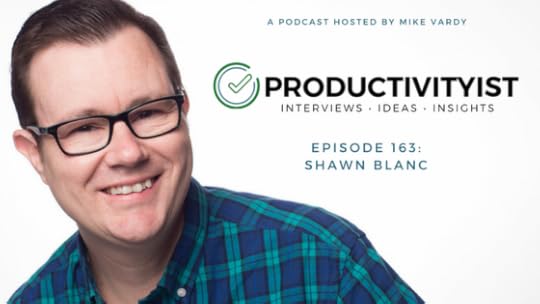
On this episode of the podcast I speak with my good friend, productivity expert, and creator of The Focus Course, Shawn Blanc.
We dive into the idea of getting out of our own way, as well as discuss our takeaways from Jeff Goins’s Tribe Conference and why showing up every day matters so much.
Relevant Links
Tribe Conference
Ryan Holiday | Website
Anthony Ongaro | Website
Overlap with Sean McCabe | The Productivityist Podcast
YesYesMarsha.com
Getting Results the Agile Way by J.D. Meier
Finish with Jon Acuff | The Productivityist Podcast
Grant Snider | Perfect
Benjamin Hardy | Medium
Tsh Oxenreider | Website
Leo Babauta | Website
Jeff Goins | Website
The Focus Course
As always, I had a great time chatting with Shawn. I hope you enjoy this conversation as much as I did.
Thanks for listening!
The post Finding Focus with Shawn Blanc appeared first on Productivityist.
September 18, 2017
Finish with Jon Acuff
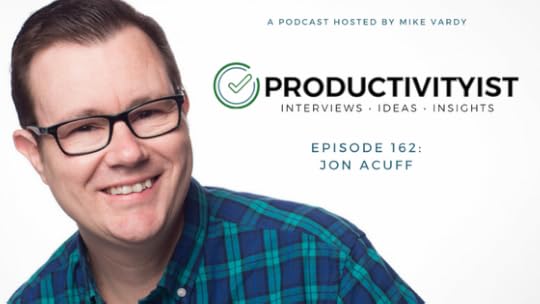
My guest this week is Jon Acuff – a New York Times bestselling author of six books with his most recent, Finish: Give Yourself the Gift of Done. Jon helps some of the world’s biggest brands tell their story and has appeared on CNN, Fox News, Good Day LA, and other major media outlets.
We discussed a sampling of the topics in his latest book which includes planning, prioritizing and reaching the state of finished no matter what you’re working on.
Relevant Links:
Jon Acuff | Website
Finish: Give Yourself the Gift of Done | Amazon
Jon Acuff | Twitter
Thanks for listening. If you enjoyed the show don’t forget to subscribe so you don’t miss a single episode. Until next time remember to stop guessing…and start going!
If you’re interested in supporting the podcast and receiving exclusive content while doing so, you’ll want to check out the patrons-only version of The Productivityist Podcast on Patreon. Also, remember to leave The Productivityist Podcast a rating and review on iTunes, or on whatever platform you’re listening to. I read every single bit of feedback we receive. I want to make this show better and with your help I can do that.
The post Finish with Jon Acuff appeared first on Productivityist.
September 11, 2017
Overlap with Sean McCabe
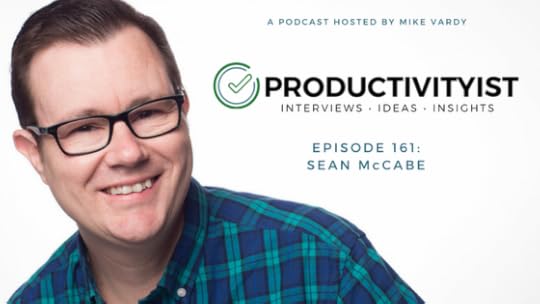
On this episode of the podcast, I am joined by Sean McCabe of the Seanwes.com. Sean is an entrepreneur, a hand lettering artist, and the guy behind the Seanwes community which connects hundreds of like-minded creatives all over the world.
We talked about starting a business and scaling it up while working a full-time job. Some of the things we discussed include how to find your passion, develop your skills as a creative, get out of the scarcity mindset and create a thriving business among many others.
Relevant Links:
Seanwes
Seanwes Community
Overlap Book
Sean McCabe | Twitter
Thanks for listening. If you enjoyed the show don’t forget to subscribe so you don’t miss a single episode. Until next time remember to stop guessing…and start going!
If you’re interested in supporting the podcast and receiving exclusive content while doing so, you’ll want to check out the patrons-only version of The Productivityist Podcast on Patreon. Also, remember to leave The Productivityist Podcast a rating and review on iTunes, or on whatever platform you’re listening to. I read every single bit of feedback we receive. I want to make this show better and with your help I can do that.
The post Overlap with Sean McCabe appeared first on Productivityist.



